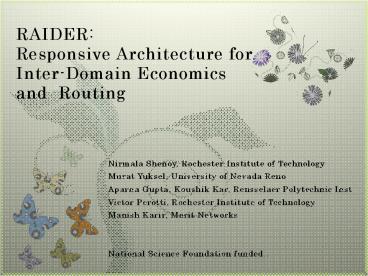RAIDER: Responsive Architecture for Inter-Domain Economics and Routing
1 / 20
Title:
RAIDER: Responsive Architecture for Inter-Domain Economics and Routing
Description:
RAIDER: Responsive Architecture for Inter-Domain Economics and Routing Outline Goals of RAIDER RAIDER Technical and Economic Components Floating Cloud Tiered (FCT ... –
Number of Views:158
Avg rating:3.0/5.0
Title: RAIDER: Responsive Architecture for Inter-Domain Economics and Routing
1
RAIDER Responsive Architecture for Inter-Domain
Economics and Routing
- Nirmala Shenoy, Rochester Institute of Technology
- Murat Yuksel, University of Nevada Reno
- Aparna Gupta, Koushik Kar, Rensselaer Polytechnic
Inst - Victor Perotti, Rochester Institute of Technology
- Manish Karir, Merit Networks
- National Science Foundation funded..
2
Outline
- Goals of RAIDER gt Future Internet
- Components of RAIDER
- Networking Component
- Floating Cloud Tiered Internetworking Model
- Service Provisioning Component
- Contract-Based Inter Domain Routing
- Economic Component
- Inter-Domain Economics and Risk Management
- Summary
- Position paper Individual results
3
Goals of RAIDER
- An internetworking architecture
- Highly Flexible and Scalable
- Technically and Economically -
- Respond to future needs of Network Users and
Providers
4
RAIDER Technical and Economic Components
Inter-Domain Economics and Risk Management
- Floating Cloud Tiered Internetworking Model
- Contract Switching
5
Floating Cloud Tiered (FCT) Internetworking Model
- Technically Responsive Architecture
- Modularity
- Granularity
- Structure to leverage
- High Interconnections
- Address mechanism
- gt Implement structure, avoid logical address
based routing
6
FCT Internetworking Model
- Building Blocks
- Network Clouds ISPs, POPs, Backbone routers
- Nested Clouds
- Tiers Global Level ISPs, AS backbone,
distribution, access - Nested Tiers
7
FCT Applied ISP Level
8
Nested Clouds, Tiers, Addresses
Nested Address 1.13.112
Nested Tiers
9
Contract Switching
10
Inter-domain Struggles
10
- When crossing domains, all bets are off..
- End-to-end reliability or performance-criticality
requires - assurance of single-domain performance, i.e.,
contracts - efficient concatenation of single-domain
contracts - Inter-domain routing needs to be aware of
economic semantics - contract routing risk management
- We address translation of these struggles to
architectural problems
11
Contract-switching A Paradigm Shift
e2e circuits
Circuit-switching
Packet-switching
Contract-switching
12
Basic Building Block Intra-domain Dynamic
Contracts
- Contract components
- performance component, e.g., capacity
- financial component, e.g., price
- time component, e.g., term
13
Contract Link
- An ISP is abstracted as a set of contract links
- Contract link an advertisable contract
- between peering/edge points i and j of an ISP
- with flexibility of advertising different prices
for edge-to-edge (g2g) intra-domain paths
capability of managing value flows at a finer
granularity than point-to-anywhere deals
14
How to Achieve e2e QoS?
- Contract Routing
- Compose e2e inter-domain contract paths over
available contract links satisfying the QoS
requirements - Calculate the contract paths by shortest-path
algos with metrics customized w.r.t. contract QoS
metrics - Two ways
- link-state contract routing at macro time-scales
- path-vector contract routing at micro time-scales
- Monitor and verify that each ISP involved in an
e2e contract path is doing the job - Punish the ISPs not doing their job, e.g. as a
money-back guarantee to the others involved in
the e2e contract path
15
Path-Vector Contract Routing Micro-level,
On-demand, Reactive
C-B-A, 5-4-2-1, 20Mb/s, 30mins, 7.33
C-B, 5-4-2, 20Mb/s, 45mins, 65
C, 5-4, 30Mb/s, 45mins, 9
ISP B
path announcement
path announcement
2
ISP A
1
4
User X
- Provider initiates
- ISP C wants to advertise availability of a
short-term contract link
3
ISP C
path announcement
5
C, 5-3, 10Mb/s, 30mins, 5
C-A, 5-3-1, 5Mb/s, 15mins, 1.251.2
16
Path-Vector Contract Routing Micro-level,
On-demand, Reactive
- User initiates
- User X wants to know if it can reach 5 with
10-30Mb/s for 15-45mins in a 10 budget
5, 10-30Mb/s, 15-45mins, 10
5, A, 1-2, 15-30Mb/s, 15-30mins, 8
5, A-B, 1-2-4, 15-20Mb/s, 20-30mins, 4
ISP B
path request
path request
2
reply
reply
A-B-C, 1-2-4-5, 20Mb/s, 30mins
1
4
ISP A
User X
reply
3
ISP C
path request
Paths to 5 are found and ISP C sends replies to
the user with two specific contract-path-vectors.
Paths to 5 are found and ISP C sends replies to
the user with two specific contract-path-vectors.
5
5, A, 1-3, 5-10Mb/s, 15-20mins, 7
A-C, 1-3-5, 10Mb/s, 15mins
17
Contract Routing over FCT Model
17
Contracting at tier-1 long time-scale
ISP A
ISP B
Tier 1
ISP C
ISP E
ISP D
Tier 2
Tier 3
Organization A
Organization B
Organization C
Contract between two tier-2 networks medium
time-scale
Contract between two tier-3 networks short
time-scale
18
Deployment Issues
18
- How to motivate ISPs to participate?
- ISPs are very protective of their contracting
terms due to competition. - But, BGP has similar risks too..
- Observation of opportunity costs
- PVCR can be done at will..
- Not much to loose if ISPs participate with their
leftover bandwidth. - Monitoring and verification of contracts
- Who is breaking the e2e performance?
- Active measurements can be OK for LSCR, but PVCR
needs lightweight techniques.
19
Summary
- A Future Internet Architecture
- Technically responsive
- Tested on Emulab / ProtoGENI
- 21 node 3 tiers
- Economically responsive
- Presented some details
- Collaboration on Integration ongoing.
20
Questions































